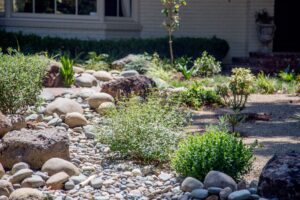By Debbie Arrington
Guest Writer
Rainwater is free; why not save some of it for later?
 During a rainy winter, capture some of that water with a “rain garden.” This method can help recharge the groundwater available for deep-rooted plants. Your trees and shrubs will appreciate it.
During a rainy winter, capture some of that water with a “rain garden.” This method can help recharge the groundwater available for deep-rooted plants. Your trees and shrubs will appreciate it.
Award-winning landscape designer Cheryl Buckwalter of Landscape Liaisons is a big fan of rain gardens and so are her clients. “I’m seeing more and more rain gardens and requests for rain gardens,” she says. “It’s exciting.”
There are so many benefits to rain gardens, Buckwalter continues. “The number one benefit: It’s a practical way to conserve water. Rainwater is free! I want to keep it on my landscape, helping my trees and shrubs, instead of running into storm drains – and carrying pollutants with it. When rainwater soaks into the soil, all those impurities – oil, grease, pesticides, fertilizers, all sorts of pollutants – are filtered out. You’re actually cleaning the water and keeping those pollutants out of streams and rivers while recharging the groundwater.”
According to the U.S. Environmental Protection Agency, 70 percent of all water pollution nationally comes from rainwater runoff. A well-constructed rain garden can filter out up to 90 percent of rainwater pollutants.
“Rain gardens also provide habitat; it’s not a monoculture like a lawn,” Buckwalter says. “Rain gardens are a magnet for birds, bees, and other wildlife. You’re providing food, shelter, and water. It’s a feel-good thing; you know you’re doing the right thing.”
Many people are still unfamiliar with the rain garden concept, Buckwalter says.
“What is a rain garden? The simple definition to me: It’s a landscaped area that’s depressed to collect, absorb, and filter water that runs off roofs and paved areas,” she explains. “Think of it as your own ‘rainwater processing facility’ that provides water to plants.”
When it comes to rainwater and runoff, most people are familiar with the concept of “slow, spread, and sink,” she continues. “Slow the water, spread the water out, then let it sink in. I add ‘store’ to that concept; a rain garden can store water for a short period of time.”
Rain gardens aren’t ponds, she adds; the water usually soaks into the soil in less than 48 hours.
“People worry they can become a breeding ground for mosquitoes, but when designed properly, that’s just not the case; it’s a myth,” Buckwalter says. “Rain gardens are shallow – under a foot deep – and the water doesn’t stand very long.”
Two other misconceptions can be barriers to creating rain gardens, she notes.
“People think their yard is too small, but rain gardens are scalable; they can be any size. It depends on where the water flows. They can be long and skinny. You could even put one in a side yard. They can be a focal point or blend into the landscape.”
The other misconception: Rain gardens are only for very rainy places. “We have so many months without rain; people ask, why create a rain garden when we don’t have rain? Because of the benefits when we do have rain.”
During a stormy winter, that little depression in the landscape can capture thousands of gallons of runoff. From 1 inch of rainfall, a 400-square-foot roof can collect 200 gallons of rainwater. (Sacramento receives 19.2 inches in a normal rain year.) Downspouts from the roof’s gutter system are extended to the rain garden via pipes, tubes, trenches, curbs, or other methods to collect the water.
Before creating a rain garden, note where water naturally flows, including landscape low points.
“Observe your landscape first,” Buckwalter says. “Where is there winter flooding? That’s the perfect spot.”
Use dirt displaced in digging the depression to create berms and barriers. Remember water needs a way to flow in (the inlet) as well as flow out (the spillway). During big storms, a rain garden can overflow; the spillway keeps that water from collecting in the wrong places such as around foundations. Cobbles or other stones often are used around the inlet to slow water’s flow. Compost improves the rain garden’s ability to let water soak into the soil; mulch retains soil moisture and keeps down weeds.
Rain gardens mimic creeks and streams in how they gather rainwater and slow it down. Buckwalter recommends viewing natural creeks for ideas. “Go into nature and look at a real stream, see how it meanders, take photos. Borrow from nature for your own landscape.”
Like a creek, a rain garden has distinct zones.
“A rain garden usually isn’t very deep – just 6 to 12 inches,” Buckwalter notes. “But it has three levels and needs different plants for each level.
“On the bottom, it needs plants that can tolerate inundation in winter – standing in water for a day or two – but like it dry during summer. On the sides, it needs plants that can tolerate wet conditions but not necessarily inundation. On the top or the banks of the river garden, plants need to tolerate dry conditions; they serve as the transition into other parts of the low-water landscape.”
Bottom plants could include native sedges, rushes, or deergrass. Other natives – Douglas iris and California goldenrod – are good choices for the sides, leading to sticky monkeyflower, yarrows, and California fuchsia on the banks. Native shrubs such as coffee berry and toyon work well around the edges in the transition zone; these deep-rooted shrubs also benefit from the rain garden’s deep soaking.
Mix some water-wise evergreens into the rain garden so it always looks fresh and has something growing year round, Buckwalter adds. To help plants get established, Buckwalter recommends installing drip irrigation along with the rain garden.
“What if we have a dry winter?” she says. “All plants need regular water while they get established.”
As resources, Buckwalter recommends for good basic information the UCANR master gardeners publication, “Coastal California Rain Gardens,” https://anrcatalog.ucanr.edu/pdf/8531.pdf. She also loves “Rain Garden Handbook for Western Washington” (https://apps.ecology.wa.gov/publications/documents/1310027.pdf).
———————————————————————————————————————————-
Debbie Arrington is a longtime home and garden reporter and co-author of the blog Sacramento Digs Gardening: https://sacdigsgardening.californialocal.com/
*

